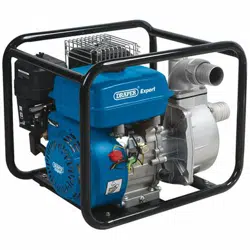Loading ...
Loading ...
Loading ...

9.3 CHECKING THE ENGINE OIL - FIGS. 7 - 8
The motor of this pump is not filled with oil.
Prior to starting the motor ensure the crank case is
filled with SAE #30 4 stroke oil.
Damage to the motor is not covered under warranty if
the motor is run without oil.
1. Before checking or refilling oil, be sure the pump is
put on a stable and level surface, ensuring the
engine has been switched OFF.
2. Remove the oil filter cap by rotating the cap
anti-clockwise and inspect to see the oil level
(Fig.6).
3. If the oil level is below the lower level line, refill
with SAE #30 4 stroke oil to the upper level line.
NOTE: Do not screw in the oil filler cap when
checking oil level, simply insert and pull the cap
straight out.
4. If the oil is contaminated or has discoloured, ensure
you change the oil. Refer to the ‘Engine oil
replacement’ section for instructions.
NOTE: This motor is fitted with a low oil sensor. If
the oil level is too low the motor will stop
operating or the motor will not start. It is advised
to check the oil level each time the pump is used.
9. SETTING THE WATER PUMP
FIG.8
FIG.7
11. MAINTENANCE
11.4 RISK OF FIRE
HAZARD
Attempting to fill the
fuel tank while the
engine is running.
Sparks, fire, hot objects
Improper storage of fuel
Tampering with factory
set engine speed
settings.
Inadequate ventilation
for water pump
Overfilling the fuel tank
– fuel spillage.
WHAT COULD HAPPEN HOW TO PREVENT IT
Fuel and fuel vapours can become ignited
by coming in contact with hot components
such as the muffler, engine exhaust gases, or
from an electrical spark.
Cigarettes, sparks, fires, or other hot objects
can cause fuel or fuel vapours to ignite.
Improperly stored fuel could lead to
accidental ignition. Fuel improperly secured
could get into the hands of children or other
unqualified persons.
Engine speed has been factory set to
provide safe operation. Tampering with the
engine speed adjustment could result in
overheating of attachments and could cause
a fire.
Materials placed against or near the water
pump or operating the water pump in areas
where the temperature exceeds 40°C.
ambient (such as storage rooms or garages)
can interfere with its proper ventilation
features causing overheating and possible
ignition of the materials or buildings.
Spilled fuel and its vapours can become
ignited from hot surfaces or sparks.
Turn engine off and allow it to cool before
adding fuel to the tank. Equip area of
operation with a fire extinguisher certified
to handle gasoline or fuel fires.
Add fuel to tank in well ventilated area.
Make sure there are no sources of ignition
near the water pump.
Store fuel in an approved container
designed to hold fuel. Store container in
secure location to prevent use by others.
Never attempt to “speed-up” the engine to
obtain more performance. Both the output
voltage and frequency will be thrown out
of standard by this practice, endangering
attachments and the user.
Operate water pump in a clean, dry, well
ventilated area.
DO NOT OPERATE UNIT INDOORS OR IN
ANY CONFINED AREA.
Use care in filling the tank to avoid spilling
fuel. Make sure fuel cap is secured tightly
and check engine for fuel leaks before
starting engine. Move water pump away
from refuelling area or any spillage before
starting engine. Allow for fuel expansion.
Never refuel with the engine running.
8. PREPARING THE WATER PUMP
FIG.1
8.1 HOSE CONNECTION - FIGS. 1 - 2
To stop the hose collapsing on the suction side of the
pump; a solid wall (reinforced) hose must be used.
Please see optional accessories section for
recommended suction hose.
i. Unscrew hose barb coupling from the pump
body.
ii. Slide the hose barb coupling over the hose barb
and attach the coupling to the pump.
iii. Slide hose clamp over the solid wall hose
before pushing the hose onto hose barb ;
making certain it has gone over all the way.
iv. Use the hose clamp to grip the hose securely onto
the connector. Make certain the clamp is central on
the connector.
NOTE: Clamp the strain filter to the other end of the
suction hose. This helps avoid larger pieces of debris
being sucked through the pump and causing damage.
Fig.3 Clean water filters 24578, 24580.
FIG.2
FIG.3
11. MAINTENANCE
11.9 RISK OF MOVING PARTS
11.10 RISK FROM LIFTING
HAZARD
Contact with moving
parts can result in
serious injury.
WHAT COULD HAPPEN HOW TO PREVENT IT
The water pump contains parts which
rotate at high speed during operation.
These parts are covered by guarding to
prevent injury.
Never operate water pump with guarding
or cover plates removed. Avoid wearing
loose fitting clothing or jewellery which
could be caught by moving parts.
HAZARD
Lifting a very heavy
object.
WHAT COULD HAPPEN HOW TO PREVENT IT
Serious injury can result from attempting to
lift too heavy an object.
When lifting, always keep the object you
are lifting near the vertical axis of your
body. DO NOT use you back to lift heavy
loads. Both people should crouch down,
grab the underside of unit and use your
legs to carry the weight. Keep the object as
near the centre of your body’s gravity as
possible. Avoid twisting your bodies when
carrying the unit; instead, turn your whole
body using your feet.
12
17
19
10
Loading ...
Loading ...
Loading ...
